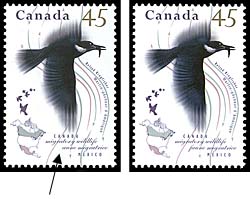
|
Elizabethan II Study Group Journal: The Corgi Times Glossary |
D | |||||||||||||||||||||||||||||
| Darnell Stamps of Canada Catalogue - specialized stamp catalogue of Canada published by
Lyse Rousseau about every other year.
See Unitrade. |
 Darnell catalogue |
||||||||||||||||||||||||||||
| Davac gum - clear and tasteless gum used on just two Canadian stamps: 5c Highway Safety (1966) and 5c Centennial of Confederation (1967). |
 Stamps with Davac gum |
||||||||||||||||||||||||||||
| Definitive - The 'common' stamps, intended for normal everyday postal use, issued in large quantities and available (typically) for several years.
Denominations used in Canada during the Elizabethan era range from 1c all the way up to $10. (see commemorative)
|
 Definitive | ||||||||||||||||||||||||||||
| Deltiology - picture postcard collecting. | |||||||||||||||||||||||||||||
| Denomination - the face value of stamp, indicated either with a numeral or a letter (the latter being non-denominated). |
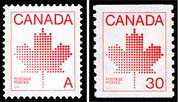 Denomination |
||||||||||||||||||||||||||||
| Design - the image on the stamp. | |||||||||||||||||||||||||||||
| Design
error - an unintentional mistake incorporated
into the stamp's design by the stamp designer that
was not noticed before printing. As many as 75
different Canadian Elizabethan-era stamps have an
error of design. A design error can fall into one of the following categories:
Occasionally the error of design will be corrected and a new stamp issued. |
 Flipped design (error on left)
|
||||||||||||||||||||||||||||
| Designer - the artist, or group of people, who prepare the artwork for a stamp. | |||||||||||||||||||||||||||||
| Dex gum - gum used on back of Canadian stamps until 1971 when it was replaced by PVA gum. | |||||||||||||||||||||||||||||
| Die cut - the separation method used around self adhesive stamps. This can be straight, curved, simulated perforations (serpentine), or any other unique shape. | |||||||||||||||||||||||||||||
| Discount postage - stamps sold at below face value. Most of the Canadian Elizabethan-era stamps can be bought in bulk via auction at a discount from face (typically 10%-20% below face value). | |||||||||||||||||||||||||||||
| Doctor blade flaw - in modern high-speed printing machines surplus ink is removed from the printing surface by a flexible steel blade, known as the doctor blade. This process can cause characteristic flaws on the printed stamps. Until worked out this can cause a non-constant flaw. |
 Doctor blade flaw |
||||||||||||||||||||||||||||
| Domestic mail - mail sent and delivered within Canada. International mail would leave the country. | |||||||||||||||||||||||||||||
| Donut flaw
- an inconstant
variety, of interest to a specialist
but with only a curiosity value, that takes the
shape of a donut. This is caused by a foreign particle on the printing plate that, when the receiving stamp paper is impressed onto the plate, resulting in an uninked area where the paper is raised slightly around the object. The same donut may appear across one or more panes of stamps, but the foreign particle will eventually wear or fall away. These flaws are quite prevalent on stamps printed by lithography (in fact, I would guess that all stamps printed by lithography will have donut flaws). |
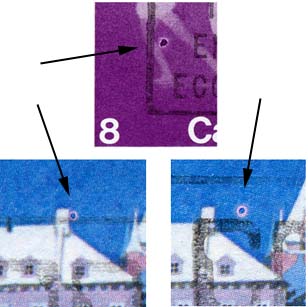 Donut flaws |
||||||||||||||||||||||||||||
| Double paper - a stamp printed on two layers of paper, typically at a splice where two rolls of paper meet. | |||||||||||||||||||||||||||||
| Double perforation - a stamp with an extra row of perforations. Many of these on Elizabethan coils have been faked. |
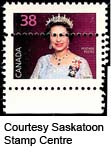 Double perforation |
||||||||||||||||||||||||||||
| Double print - a portion (or all) of the stamp design that is doubled. |
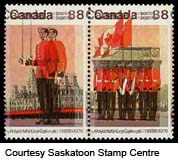 |
||||||||||||||||||||||||||||
| Drop letter - a letter delivered from the same post office as it was dropped at. These could be posted at the drop (or local) letter rate. In Canada, the first class local letter rate ended on October 31, 1968. Until this time, the 0-1oz. rate was 1-cent less the forward letter rate. | |||||||||||||||||||||||||||||
| Dull paper - a level of paper fluorescence seen under an ultraviolet light. Dull paper has very little reaction to the UV light and will appear dark, leaning towards a 'black' colour. | |||||||||||||||||||||||||||||
| Dummy stamps - an officially produced imitation stamp used to train employees, test printing equipment or test stamp-dispensing machines. | |||||||||||||||||||||||||||||
| Duplex cancel - a two-part postal marking comprised of a canceler and a postmark. The canceler voids the stamp so it cannot be reused. The postmark notes the place and date of mailing. | |||||||||||||||||||||||||||||
|
© 2001-2017, 2018 Website design by: Adminware Corporation. For information or questions regarding this website, please contact Robin Harris |
